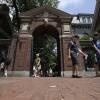For years, Boston’s Seaport District was ugly and unloved, dismissed as a virtual wasteland of parking lots and shabby industrial buildings. But those vast acres of underused space also presented Boston with a once-in-a-lifetime opportunity — the chance to build a distinctive new neighborhood from scratch, right at the harbor’s edge. But as the Seaport District takes shape, some fear the development now underway is falling short.
Standing on a high point on Summer Street – not far from the sprawling Boston Convention and Exhibition Center – you can watch as the Seaport takes shape. Construction cranes dot the landscape. And increasingly, so do sleek glass towers.
Stretching from the Moakley Courthouse to the Boston Convention Center, the Seaport is 1,000 acres. With so much land at stake, some question whether what's being built reflects the potential of this neighborhood, an area dubbed the Innovation District.
"I would say it’s not the most creative architecture," said Vivian Li head of the nonprofit Boston Harbor Association. "You look around here as we talk about the 21st century, the waterfront could be so much more."
For decades, Li has kept careful watch on Seaport development plans.
"You know, you see these beautiful drawings done by an architect and then you see it in reality and — this is what we really signed off on?" she said.
Her concern, shared by others, is that in a city known for diverse and distinct architecture — think Back Bay or Beacon Hill — what’s being built in the Seaport is generic, a style of building that could just as easily be found anywhere in the country.
"If you think about other waterfront cities, think about things that are fun," she said.
Li cites Sydney's famous Opera House — and, closer to home, the giant arch at Rowe's Wharf that frames Boston Harbor.
"We need a signature building down here, something like that," she said. "Otherwise, what you have is just rectangular glass buildings."
But glass buildings provide something people want: expansive water views. On the 15th floor at One Marina Park Drive, the boats below in Boston Harbor look like toys. This is the view from developer Joe Fallon's office.
"Right now, we have two buildings that are under construction and three buildings that are up," Fallon said.
Fallon is developing Fan Pier, a nine-block stretch in the Seaport named for the train tracks that once fanned out to meet cargo ships. Today it's home to life-sciences giant Vertex Pharmaceuticals, and Fallon is building another tower for the law firm Goodwin Procter.
"The city itself has asked, and we continue to look at adding glass and adding a modern feeling to the design," he said.
He says that modern feel fits this neighborhood where the vibe is young and the emerging mix of restaurants, retail and residences appeals to people looking for a 24/7 lifestyle. Is there going to be something about it that will distinguish it from other cities, that will give it a unique, iconic look?
"The designs that we’re employing — we’ve brought in a number of architects and designs that we’ve been working with — give it a different feel," he said.
One of the biggest design challenges in the Seaport comes from overhead. Planes heading to and from Logan Airport fly so low in this area that the Federal Aviation Administration has restricted building heights.
"That’s a real challenge for architects," said architect David Hacin. "You’ve got demands placed by tenants. They want a certain amount of square footage on the floor and the building can only be so high, it makes building that are fairly blocky."
Hacin believes the success of the Seaport will depend on how inviting it feels to pedestrians. His own contribution: District Hall, a building that looks both modern and industrial. Only a few stories high, it was created as a public gathering space and includes an outdoor café that spills into the street.
"It satisfies that interest I have in making sure the ground plane of the district is really active and engaging," he said.
Hacin also likes a Seaport development called Liberty Wharf — a collection of restaurants where open-air patios connect to a public dock overlooking the harbor.
"It’s very popular, very engaging — restaurant and people want to be near the water and it feels very good that way," he said. "Other buildings in the district aren’t as friendly."
He worries sheer glass walls will create barriers in a neighborhood meant to foster collaboration. But with so much yet to be built, critics also hold out hope.
"Every time I see a parking lot, I’ll say, 'There’s a chance we’re going to get something a little bit different, a little bit more creative,'" Li said.
There's still time — and space. For an old city, it's a big opportunity to create something new and distinctive.
Watch the Greater Boston segment:




